By Sophia and Kate Ball
It’s Learning Disability Week from 19th June, so we’re getting in early with this blog about transport and active travel provision for Learning Disabled people. Campaigns and Policy Officer Kate Ball’s daughter Sophia was extremely keen to share her thoughts and artworks with all of you: We hope it helps you think in new ways about just how important accessible transport options are for many Learning Disabled people.
Sophia is 12 years old. She loves socialising, dance, gaming and creating. She’s great at making friends and is always full of energy.
Sophia is Learning Disabled, neurodivergent and attends a special school.
“I will go to school on my scooter. When I’m bigger. Can I do it next year?” she asks.
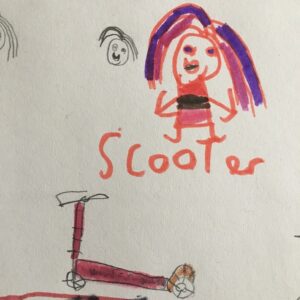
Sophia is disappointed that her brothers go to school by themselves, but she has to stay with a parent.
“What do we need to do, to make scooting to school safe for you?” I say.
“I need someone teach me. How to look both ways for the cars. When they don’t stop for the green man. You can help me.”
A van driver whizzed through our green crossing this morning. Again.
Sophia demonstrates careful looking both ways: She’s got safe crossing rules nailed. Too many drivers haven’t.
Sophia cycles to school on her tandem every day. She walks, runs and scoots most journeys, and loves going on the bus and train. She’s got the same kinds of ambitions for the future as any other adolescent: Being learning Disabled doesn’t make a person want anything different from non-Disabled people.
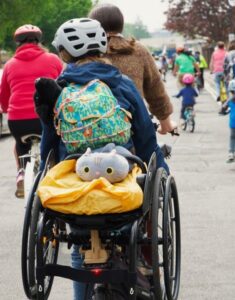
“I’m going to go to London. On the train. And I will live there, and I’ll go to my work. And have a dog. And my friends. And I will go to the shops and buy my food and cook it… And you can visit,” she offers.
Then she stops. A bit annoyed.
“I can ride a bike” she says. “You don’t let me.”
It’s totally true. She can ride a bike. And we don’t let her ride one for journeys.
Like many other people, Sophia finds it hard to work out what the people around her are likely to do in different situations. That means she’s unlikely to ever be able to pass a driving test[i]. It means she needs lots of practice to move safely around other people – even when she’s walking or scooting – and it means she is unable to walk, scoot or cycle by herself anywhere there might be moving vehicles.
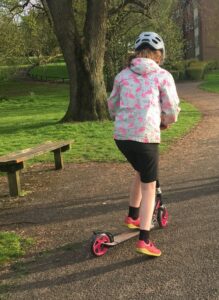
The fact that malicious people prey on those they perceive as vulnerable means Sophia is also at particularly high risk of being harassed or assaulted: Traffic-free routes in parks, nature reserves or along old rail or canal paths will be especially hazardous places for her.
It’s hard to become independent when society thinks you’ll always be with a carer. A widespread assumption is that, as a learning Disabled person, Sophia will never go on everyday trips by herself – shopping, to see friends, to clubs or to school or to work. Many people think Disabled people won’t even want to go out alone: They haven’t realised that being totally dependent on others to leave your house is at best annoying and at worst seriously incapacitating.
Many systems are set up in ways that promote dependence. For example, local authorities mainly transport Disabled children and teens to school in supervised taxis, rather than providing support to help Disabled children learn how to use walking, wheeling, cycling and public transport for these same regular journeys. Learning Disabled adults are already likely to be unemployed[ii] and live in poverty[iii]: They’re unlikely to have cars or be able to afford taxis. If learning Disabled people are not given the opportunity to learn how get safely around their local area by themselves, then people who would be perfectly capable of learning to travel independently can end up isolated, with no journey-making options at all.
It’s the same issue with cycle training, which tends to focus on single bicycles and assume that once a person can pedal around in a playground, they’re ready for on-road riding.
And we’ve not even got on to the inadequacy of public transport in many areas, nor how infrastructure is still frequently being designed in ways that exclude Disabled people from walking, wheeling, cycling and public transport, baking Disabled exclusion and dependence into our whole built environment.
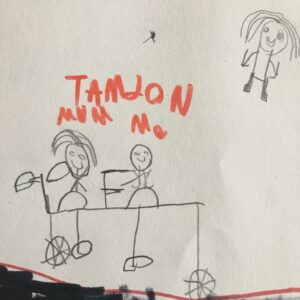
Sophia can see her end game: Independent travel, wherever and whenever she wants to go, by any mode she would like, with minimal help from anyone else.
As her parents, we see more barriers in the way of that happening than Sophia does. Most of them are nothing to do with her impairments: The blocks stopping Sophia from travelling independently are mostly our society’s assumptions and choices, and they can be changed.
“And when you’ve writed it all down, people will help me and I can go on my scooter. By myself.” says Sophia.
“Not right away” I explain. “You’re helping people understand better. And we’ll help you learn how to ride your scooter to school by yourself, too. When you’re ready.”
“Yes. It’s on my EHCP[iv]. Going to school. By myself. You have to do it.” She stops, then taps the iPad we’re recording on. “And it will go on the internet? With pictures?”
“Would you like that?”
“Yes. Then everyone can see.”
So here it is. On the internet. With pictures.
So everyone can see.
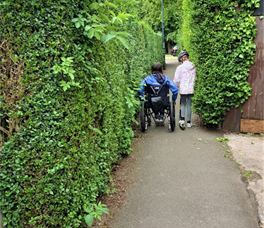
References
[i] Only 55% of working-age Disabled people have a driving license. Someone like Sophia, with an impairment which significantly affects her decision making ability, will almost certainly never be able to pass a driving test: https://assets.publishing.service.gov.uk/government/uploads/system/uploads/attachment_data/file/1019477/transport-disability-and-accessibility-statistics-england-2020.pdf
[ii] Working age people with a “severe or specific learning impairment” have an employment rate of 24.5% vs 52.6% for all Disabled people and 82.5% for non-Disabled people, from government ONS data: https://www.gov.uk/government/statistics/the-employment-of-disabled-people-2022/employment-of-disabled-people-2022
But counting only learning Disabled people receiving support as adults via NHS SALT data, BASE states proportion of learning Disabled adults in paid employment is just 4.9% https://www.base-uk.org/employment-rates
[iii] https://www.disabilityrightsuk.org/news/2020/february/nearly-half-everyone-poverty-either-disabled-person-or-lives-disabled-person
[iv] EHCP: Education, Health and Care Plan. Replaced the old Statement of Special Educational Needs. Describes the support a child or young person aged up to 25 needs to be included in education. Education section of an EHCP is legally binding for local authorities. Health and care sections are non-binding.
